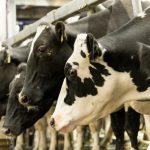
Ledman is Rabobank’s global dairy strategist and Laine is Rabobank’s VP of dairy research. The economists point out the next 12 months are fraught with uncertainty in global milk production, dairy consumption and trade. As a result, they are projecting Class III prices to hover in the $15 to $16 range over the next 12 months, slightly lower than current future prices. They are forecasting Class IV prices even lower than that, and much lower than current futures prices.
One of the big issues is how milk production will rebound. “Expect positive growth in milk production in the ‘Big 7’ dairy regions through the first half of 2021,” says Ledman. (She defines the ‘Big 7’ as the European Union, the United States, New Zealand, Australia, Argentina, Brazil and Uruguay.)
U.S. milk production could increase by more than a 1 percent for the year, and could be closer to 1.5% if the July’s increased production in an indicator of things to come, she says. Oceania’s production could also climb 1 to 1.5% during its 2020/2021 production year.
Another factor here in the United States is that a major new cheese production facility in Michigan could come online in the 4th quarter this year and will likely ramp up production through 2021. That could put additional pressure on U.S. cheese prices.
The big unknown globally is whether importing countries will continue to do so. Ledman notes that China’s dairy imports have fallen 15% year-over-year in 2020 thus far, and that it is planning to add a million cows to its inventory (an 8% increase) over the next year or two. While other Asian countries have picked up the slack in dairy imports, its uncertain whether they will continue to do so. Lower oil prices mean oil producing countries also have less hard currency to import food.
Laine points out that government programs, both in direct aid to farmers and through food box aid to consumers, played a big role in bolstering dairy commodity prices this summer. Europe had a program to move dairy products into public storage to bolster prices. While the Food Box program has been extended for a third round, it’s uncertain if the other programs will be renewed.
All of this adds up heightened volatility and uncertainty on the path to a new normal, they say.
























